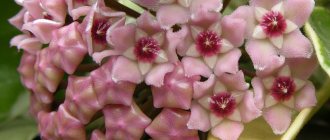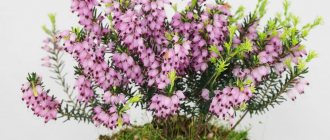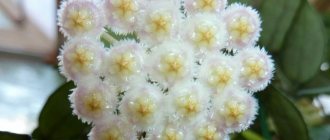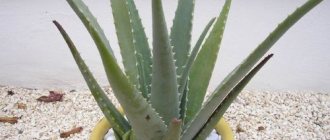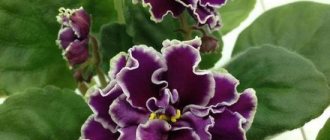The orchid that will be discussed in this article is truly a noble species, and it has no equal. Experienced gardeners are proud to have this specimen in their collection, not only because caring for the plant requires certain measures, but also because it is difficult to acquire.
Wild Cat - got its name for the special color and velvety structure of the petals.
The wild cat is a hybrid. This is Doritenopsis - a variety obtained from crossing the Phalaenopsis pleasant and Doritis most beautiful orchids.
Features of the plant and photo
Wild Cat blooms twice a year. The plant can produce a peduncle up to 60 cm long. The flowers are large (about 10 cm in diameter).
Petals and sepals are white or yellow with cherry-purple spots, the lip is slightly brighter with yellow streaks. Inflorescences are racemose, apical. The top of the peduncle gradually grows, forming more and more new flower buds, which bloom one after another.
general characteristics
Phalaenopsis Kaoda or “black beauty” is the youngest orchid hybrid. The main task of scientists was to obtain a plant with flowers of the darkest possible color. Its petals are dense, waxy, and create a shiny effect in the light. The height is average: the stem reaches 0.2 m, usually it is hidden under the leaf blades.
The leaves reach 22 cm in length, 8 - 10 in width. The leaf color is dark green. Young plants are smaller. The arrow grows from a leaf rosette. The peduncle is sometimes branched. The formation of two peduncles is possible.
From ten to fifteen buds bloom on one arrow. The color of the buds is purple or brown. The shape of the petals is regular, sometimes with a white border. The lip is white, with purple splashes, and bifurcates at the end. The diameter of the flowers is 4 – 5 cm.
The light aroma of Kaoda can be detected in the morning and evening, when the humidity rises.
Difference from other species
As already mentioned, this species is notable for its characteristic “wild” coloring and velvety flower petals .
In addition, the Wild Cat is a hybrid and a significant difference from other species is its care features. The flower loves humidity: moist soil, moist air.
It is worth considering that you should not overwater the plant and over-humidify the air at low room temperatures. The optimal air temperature is 23 degrees, but even at a temperature of 10 degrees the plant feels comfortable. The main thing is that at low temperatures the room is not too damp.
Phalaenopsis Orchid Wild Cat
"Wild Cat" is one of the rare phalaenopsis found in home floriculture. The Philippines and Australia are considered the homeland of his ancestors.
The pedigree includes about 20 species, the founders of which were Phalaenopsis "Ho's Fantastic Mirage Tin-Fan Ho" - the seed parent and pollen parent of Phalaenopsis "Jiuhbao Red Rose Jiuh Bao Biotech".
Possessing excellent genes, it is valued for its noble appearance, willfulness and grace.
Flower growers explain the rarity of this type of phalaenopsis by the difficulty of ordering. The minimum order quantity is 10 pieces, which is not affordable for everyone.
Important! Even experts cannot always accurately identify this hybrid, since it is similar to dozens of hybrids.
A distinctive feature of this rare species is not only the unique and beautiful coloring, mainly violet-purple spots on a white-yellow background , but also the density of the waxy and sparkling flower.
Depending on the lighting in the room, the quality of water and fertilizing, color saturation and color scheme may vary. The inclusions may be smaller or larger.
Photo of Phalaenopsis Wild cat.
Bloom
The wild cat blooms twice a year for 2-3 months .
This species practically does not hibernate, so the development process is constant and active. Gardeners are very fond of the Wild Cat for these properties. If flowering does not occur within a year, then this is a reason to be wary and take measures to restore the plant.
Wild cat is a whimsical flower , but if you follow all the rules of care, it will delight you with its flowering all year round:
- sufficient lighting,
- proper watering,
- absence of stress (transplantation, draft, waterlogging),
- no unnecessary movements of the flower pot.
Brief Definition
The orchid family is vast and includes many species . The most common of them is phalaenopsis, a beautiful and unassuming flower. It belongs to the genus of epiphytic, less often lithophytic plants. Its homeland is southern Asian countries such as India or China.
The Wildcat orchid, which will be discussed below, grows in the mountain forests of the Philippines and the wet plains of Australia. The name of the species - translated as "like a butterfly" - was given by Carl Blum, who mixed a phalaenopsis orchid flower with a butterfly in the dark.
Cost, where to find?
Wild cat is a rare variety . It is difficult to get and when buying such a plant you need to make sure that the species is correct. Therefore, it is best to take a flower with a blossoming bud.
Average cost of an adult plant: 1600-2000 rubles.
You can find Wild Cat in specialized flower shops or online (that is, buy it second-hand). In both the first and second cases, you must make sure that the roots of the plant do not have white coating or rot, the trunk is hard, and the leaves are fleshy and bright green. The flowers are large with a characteristic color and a light glossy coating (this is wax, a characteristic feature of the flowering of healthy phalaenopsis).
You can purchase a non-flowering plant in specialized stores. The disadvantage of such a purchase is that you will not be able to find out exactly what variety the seller sold you. And the advantage of such an acquisition is that it is much cheaper than buying a flowering plant.
The average price of a plant without arrows and peduncles: 600 – 1000 rubles.
Feeding
Fertilizing is an essential element of care. Fertilizers are added to the water for irrigation every third procedure. For this purpose, special compositions for orchids are used. Plants need fertilizers for development and flowering, since they grow in ordinary bark.
To retain moisture in pots, some gardeners use sphagnum moss. They cover the roots from above. This simple method allows you to avoid frequent watering. Moss is an excellent helper during hot periods.
Sometimes it is added to the soil. In this case, it is necessary to carefully monitor the condition of the roots, since the moss retains moisture in the pot. And this can lead to excessive watering of plants and further rotting of the root system. Many gardeners recommend using large bark for planting, which securely holds the orchid in the pot.
Reproduction
Before talking about propagation methods, it is worth touching on the topic of selecting pots and soil, as well as care in the first half of the year of the plant’s life.
Choosing a pot
Orchids are aerial root plants. Therefore, the roots of this plant need a lot of oxygen, as well as lighting . Therefore, it is necessary to choose transparent or translucent pots for the plant.
There are also special pots for orchids. If you still want to plant a plant in a beautiful pot, then it is better to choose a non-porous, flat pot or flowerpot. For such pots, you can purchase a special “crown” so that the plant stands firmly and feels good.
Soil selection
For an orchid, you can buy a ready-made substrate in the store or make it yourself from pine bark (boiled and crushed), sphagnum moss and peat. also put moss on top of the Wild Cat's roots , which is sold in specialized stores. Moss retains moisture well and does not allow the plant to dry out.
Reproduction methods
Phalaenopsis reproduce at home in 3 ways.
Children
They can only appear at very high temperatures, so this must be taken into account. If they are absent for a long time, then the plant can be stimulated.
- To do this, you need to make an incision on the kidney located closest to the main arrow. It is best to make an incision with a very sharp object.
- Using tweezers, remove the cut scales.
- Treat the opened bud immediately with a stimulant.
Literally a month after this, a baby will appear at the place of the cut. There is no need to cut it off immediately after it appears. You need to wait until the roots appear, as well as at least two leaves. Only after this can it be carefully cut and transplanted into a separate pot, where the soil has been prepared in advance.
Peduncles
- After flowering, cut off the living peduncle and divide it into parts, each of which should have at least 1 dormant bud.
- Germinate them in a special greenhouse with moss at a temperature of 25-27 ℃.
- Plant in a permanent pot when a root of at least 5 cm appears.
Dividing the bush
- Prepare containers for transplantation in advance.
- Carefully remove the plant from the pot without damaging the roots.
- Use your fingers to carefully separate the plant in those places where it is more comfortable to do so. If the roots are too close to each other somewhere, then it is better not to separate them. The easiest way to make division is to start from the outer leaves and their root component.
- If bad roots are found, they should be carefully cut off with pruners or a very sharp knife.
- Carefully treat all places where there were cuts or damage to the roots with a special solution.
With this method of propagation, the plant will not bloom for 2-3 years.
The first months after rooting
If you take good care of the plant in the first month and it takes root well, then you can do a light feeding and repeat the light feeding every 2-3 months until the plant grows and gets stronger, and subsequently produces gorgeous flowers.
Soil requirements
Planting an orchid requires special soil. Experts recommend purchasing it in a store. The substrate usually consists of steamed pine bark, the size of the pieces varies from manufacturer to manufacturer. Sometimes charcoal and sphagnum moss are added to the soil. If you wish, you can do this yourself. The presence of moss in a pot is a purely individual matter. Some gardeners practice its use, while others do not. In addition, the substrate may contain coconut chips and fern root.
High-quality soil should have the following properties:
After purchasing an orchid, it needs to create the right conditions. The plant must adapt to your home. He needs to choose a well-lit place with diffused light. Healthy plants are not replanted. Orchids can be grown in a purchased pot for several years.
Plant care
First, it’s worth touching on the topic of caring for a plant after purchasing it. A wild cat needs to settle into a new place: get used to the temperature and light. It is necessary to immediately find a place for the plant where it will live and check whether the roots are dry.
If the roots are dry, then it is best to soak them for literally 3-5 minutes, then place the flower and do not touch it for a week. After this, gradually accustom it to watering.
Temperature
For a normal life, a flower needs to maintain a temperature: 25-30 degrees in summer, 20-23 degrees in winter . After the full flowering cycle, the plant can be moved to the shade for 2 weeks, where the temperature is kept around 10-15 degrees, while it should not be over-watered either by watering or by general air humidity. This procedure is not necessary. It will help put the orchid into a light hibernation and restore strength after flowering, which will result in more luxuriant flowering in the future.
Lighting
A wild cat loves bright lighting; daylight hours at any time of the year should average 12 hours. It is worth remembering that direct sunlight is extremely harmful to leaves. Therefore, it is worth placing the plant in a place of diffused light. You can also light plants artificially. For this purpose, optimal LED and fluorescent lamps are used. Completely artificial lighting is not advisable; the plant should receive at least some sunlight.
Watering
Orchid loves moisture. On average, watering should be done 2 times a week , but avoid overwatering. To accurately determine that the roots are dry enough for the next watering, you can look at them through a transparent pot or crown.
If the roots are bright green, then the flower still has enough moisture; if it is light green, then it needs to be watered. Also, the plant should not be watered at night, because it is sleeping, and under no circumstances should you water it in the middle - this will lead to rapid rotting.
There is also a good practice among gardeners: do not water the orchid, but “soak” it in a basin . The principle is simple:
- Pour water at room temperature into a basin so that the water does not touch the leaves and upper roots where the stem begins (optimally - 2/3 of the height of the pot).
- Leave the flower for 10-15 minutes.
- Now you can not water the plant for a whole week and not worry that it is not saturated enough.
Top dressing
Flower shops have a huge selection of fertilizers for orchids. You can also find various antiseptics for roots, healing and stimulating herbal preparations.
The main rule for feeding orchids is that if the plant is blooming, it should not be fed. The rest of the time, fertilizing can be done once every 2-3 months.
Trimming
For the Wild Cat, trimming the peduncle is the last thing. The arrow is capable of producing new shoots and flowers even after a year. The arrow should only be cut if it has dried out . This must be done with a sharp knife or pruning shears 2 cm above the first dormant shoot.
Transfer
Phalaenopsis should be replanted only when absolutely necessary (root disease) or once every 2 years. And then, this needs to be done only because the land is depleted during this time and needs to be renewed.
- The old pot is cut so as not to damage the delicate and very brittle roots.
- Rotten and damaged roots are cut off.
- The cut areas are treated with crushed activated carbon or cinnamon powder.
- Drainage 2 cm thick from inert components is poured onto the bottom.
- Then the plant is carefully lowered into a container, which, sequentially, filling all the voids and lightly compacting, is filled with bark - 1.5-2 cm; Pieces of charcoal are added to the bark as a sorbent.
Care during the flowering period
Care during the flowering period comes down to regular watering and sufficient light . The only thing that should be excluded is fertilizing and replanting.
What to do if the buds don't appear?
First you need to ask yourself: how old is the plant?
An orchid does not bloom until three years after it has fully matured.
If the plant is old enough, then there is a possibility that the plant has received insufficient care or is sick. Review all care points, check the plant for diseases. If everything is fine with the plant, then you should just wait. Phalaenopsis can sometimes be very whimsical and they need a little time to show all their beauty.
How to care?
This plant is considered a difficult flower to grow - it requires proper care, which includes several stages.
First of all, the plant must go through the adaptation stage. At this time, he needs good lighting and the right temperature conditions. The air temperature in the place where it grows should not exceed 25 or drop below 14 degrees. In addition, it is important for the orchid to maintain indoor air humidity no higher than 50 percent.
After purchase, the orchid can remain in the same pot for several years. Transplantation should be done only when absolutely necessary and only after the plant has flowered. After flowering, it is recommended to place the phalaenopsis in a cooler place, and also significantly reduce its watering.
This must be done so that in the future the inflorescences will be lush and beautiful. After a certain time, the flower can be treated with warm water.
Very often, orchids stop blooming after purchase. Then the plant will need to be stimulated. To do this, you need to try to slightly increase the difference between daytime and nighttime. In addition, orchids need special soil, which is recommended to be purchased at flower shops. Most often, such soil consists of pine bark and charcoal. It also contains sphagnum moss; if it is not there, then you can add it yourself. In addition to all these components, fern root or special coconut chips are added to the soil.
The room with the flower must be regularly ventilated. This must be done in such a way that there is no draft, which will only harm the orchid.
Top dressing
Do not also forget about applying various fertilizers. They are simply necessary for these plants living in ordinary bark. Most often, fertilizers are added to water. It is recommended to do this after every third watering. Fertilizers for orchids are most often sold in flower shops.
Watering
To retain moisture, sphagnum moss is often used to cover the roots of the plant. It protects the orchid from heat and also prevents moisture from quickly evaporating. The “Wild Cat” orchid also needs to be watered correctly. She feels better in the case of a lack of water than in an excess of moisture.
There are several ways to water such a plant. One of them is to immerse the pot in a container of boiled and cooled water for about half an hour. Then it must be removed from the water and the excess moisture allowed to drain. Further watering can be done only when the bark is completely dry. It is imperative to monitor the condition of the root system. Until the condensation on the walls of the pot disappears, the plant does not need to be watered.
The orchid can be watered by spraying. In addition, if the weather is hot, the amount of watering increases accordingly, and as it decreases, it decreases.
Disease and pest control
The orchid is distinguished by the fact that with proper care it practically does not get sick. And if he gets sick, he is treated quickly enough. These diseases include different types of rot. For example, gray rot and fusarium. To get rid of them, you need to cut off the infected area, then sprinkle the cut area with charcoal powder or treat it with a special disinfectant solution.
But only various pests can greatly spoil the life of both the orchid and the novice gardener. In this case, the plant begins to dry out and wither. Such plants must be immediately isolated, and the window and window sill must be treated with a special soap solution with the addition of baking soda. The proportions in this case are equal: 1 teaspoon of soda to 1 glass of soap solution. This mixture will stop the reproduction of parasites.
Among other things, plants that were nearby should also be treated with a soap solution, but only without using soda. After some time, they must be rinsed with clean water. In case of nematode damage, the orchid must be treated with decaris solution or other special means. If aphids appear, then the plant must be immediately treated with an onion solution or a solution of lemon zest. Such folk remedies are infused for three days. After this they are ready for use.
If phalaenopsis is affected by soft-bodied mites, then they must be combated only with special preparations. It could be Fitoverm. If oribatid mites appear, the plant must be replanted, but before doing this, be sure to soak it in warm water for at least half an hour so that the insects float to the surface. After this, they must be collected, and the roots of the plant must be dried. Only then can the plant be transplanted into new soil.
In addition, it is necessary to carry out regular preventive work using various fungicides or insecticides so that no diseases subsequently appear.
Trimming
You should not prune your orchid immediately after flowering. In addition, you can only remove those flower stalks that are completely dry. The flower must be trimmed to the very first dormant bud. A new shoot may subsequently appear from it.
After trimming, all sections must be treated with a special disinfectant.
After some time, side branches may appear, on which new flowers will appear.
Diseases and pests
A wild cat, like all orchids, rarely succumbs to various diseases with proper care. It is also easily treated with simple medications. This variety is mainly affected by fusarium and gray rot . These diseases are treated with specialized medications and removal of the affected parts. Common pests include thrips and spider mites. They are also removed with special drugs.
The best method to protect a plant from all diseases and parasites is to follow proper care and take timely treatment measures.
In general, the Wild Cat orchid is a fairly easy-to-care plant that is ready to delight its owner with bright and long flowering.
Possible difficulties during cultivation
There are three main difficulties that you may encounter when raising a Wildcat at home. However, with proper care, you most likely will not encounter any of them.
- Root rotting. In this case, it is worth reducing the number of waterings.
- Lethargy and yellowing of leaves. It is worth making sure that the plant receives enough light and is not burned by the sun. If this does not help, you need to adjust the watering and temperature conditions.
- Drying and darkening of roots. In such a situation, it is worth temporarily abandoning feeding.
